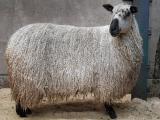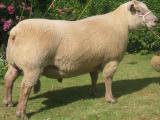
|
Spanish Merino sheepA number of sheep breeding nations, including Phoenicia, Italy, and Spain, are believed to have played a part in the development of the Merino sheep. However, it is generally agreed upon that the Moors, who dominated Spain through the eighth to thirteenth centuries, were primarily responsible for selectively breeding the animals to such an extent that the wool they produced became superior to that of all other sheep. |

|
St. Croix sheepThe St. Croix is a hair sheep that originated in the Virgin Islands, where it is called the "Virgin Island White." The breed is believed to have descended from the hair sheep of West Africa, but some feel it is a cross of the Wiltshire Horn and the native Criollo. Most of these sheep are white with some solid tan, brown, black or white with brown or black spots. |

|
Steinschaf sheepThe Steinschaf is a direct descendent of the now extinct Zaupelschaf. It had developed characteristics that made it perfect for life in the high mountains in the Eastern Alpine regions. In the beginning of the 20th century the Steinschaf still roamed the meadows of Bavaria, Germany, especially the areas around Berchtesgaden, Traunstein, and Rosenheim. In Austria, its range was mainly in the Salzburg area |

|
Suffolk sheepSuffolks are found throughout the world's sheep producing countries. In the United States, they are by far the most popular pure breed of sheep, accounting for more than fifty percent of purebred sheep registrations. In the British Isles, they are the leading terminal sire breed. The Suffolk breed originated almost 200 years ago on the rugged southeastern coast of England, the result of crossing Southdown rams and Norfolk Horn ewes. Originally, they were called Southdown Norfolks or just "Black faces." |

|
Swaledale sheepThe breed's origin almost cerainly emerged from the genetic group of horned sheep from which also came the Blackface, the Rough Fell, and other localized types. |

|
Swifter sheepThe Swifter is a new, highly productive sheep breed, which was developed in the 1970's by the Agricultural University in Wageningen, the Netherlands, to increase the productivity of the Dutch sheep stock. Swifters are used as dams for slaughter lambs. |

|
Swiss Black-Brown Mountain sheepThe Swiss Black-Brown Mountain originates from the ancient Swiss breeds Jura, Simmentaler, Saanen, Frutiger, Roux de Bagnes and Freiburger. It is a polled, medium-sized sheep, deep, and broad. The coat color is either black, chestnut colored, or light brown. Head and legs are clear of wool, covered with short black or brown hairs. The fleece of the Swiss Black-Brown Mountain is of single-color, thick, and close-cropped. |

|
Swiss White Alpine sheepThe Swiss White Alpine is a short-wooled breed kept primarily for meat. The breed originated in Switzerland in 1936 from a cross between the Swiss White Mountain and 50 to 75% Ile-de-France. |

|
Tan sheepTan sheep are famous for their fur with long curled hair. The wool of Tan sheep is soft, light and puffy, with long and even fiber, suitable for making high-grade blankets, shawls and scarves. Tan sheep are raised in the desert and semi-desert regions of China. |

|
Targhee sheepThe Targhee is one of America's youngest breeds. It was developed in 1926 at the U.S. Sheep Experiment Station in Dubois, Idaho, from Rambouillet, Columbia and Corriedale crosses. The Targhee derives its name from the Targhee National Forest on which the experiment station's flock grazes in the summer. The forest was named for a chief of the Bannock Indians who had lived in the area in the 1860's. |

|
Teeswater sheepTeeswater, a longwool sheep from Teesdale in the County of Durham, located in Northern England, have for almost 200 years been bred by farmers in that area of the north. Until the 1920's, the breed was comparatively rare, but now they are to be found in almost every part of the U.K. |

|
Texas Dall sheepThe Texas Dall has no relation to the Alaskan Dall. It is a hybrid, a cross between domestic sheep (Rambouillet and Barbados Blackbelly) and the European Mouflon. |

|
Texel sheepThe Texel originated on the Isle of Texel off the coast of the Netherlands early in the nineteenth century. They became available to U.S. sheep producers in 1990 when they were released from quarantine at the U.S. Meat Animal Research Center in Clay Center, Nebraska, where they were evaluated for their potential in crossbred lamb production. |

|
Tong sheepTong sheep originate from Mongolian sheep. They are able to withstand unfavorable environmental conditions and are found in the high plains of the northern Shaaxi Province of China, where the average temperature is 13°C and annual precipitation is 520 to 600 mm (20-24 in). Their wool is carpet wool. Wool production is low. |

|
Tsigai sheepTsigai sheep originated in Southeast Europe, where they are raised for meat and milk. There are many variations of the breed. |

|
Tukidale sheepTechnically, the Tukidale is a not a new breed of sheep, but rather a Romney sheep carrying the T gene for hair. The breed originated on M.W. Coop's property in New Zealand from a ram born November 26, 1966. The ram possesed the T gene, which is dominant. The T gene is responsible not only for producing the specialty carpet-type fleece, but also the formation of horns in the in the male and, to a lesser extent in females. |

|
Tunis sheepThe Tunis is one of the oldest sheep breeds, said to have roamed the hills of Tunis and parts of Algeria in North Africa prior to the Christian era. The American Tunis evolved from a number of importations of fat-tailed sheep from Africa and the Middle East that were crossed with established European breeds to improve the breed's meat characteristics. |

|
Turki sheepAfghanistan is home to many of Central Asia's most unique breeds of sheep that are particularly well-adapted to the local conditions and highly valuable commercially. The most notable is the largest breed of fat-rumped sheep, the Turki. |

|
Tyrol Mountain sheepThis breed is found in Tyrol of Austria and Bolzano of Italy. It is a coarse wooled breed, belonging to the Lop-eared Alpine group, which is kept for meat production. |

|
Ujumqin sheepThe Ujumqin, a larger version of the Mongolian, is found in Inner Mongolia, China. It has a fat tail 28 cm (11.2 in) long by 36 cm (14.4 in) wide in the male, and 22 cm long by 28 cm (8.8 in) wide in the female. When dressed, the tail fat weighs 2 kg (4.4 lbs) or more. The Ujumqin was developed due to the sharp seasonal contrast in plant growth in the pastoral areas. |

|
Valachian sheepThe Valachian is a highly endangered landrace sheep. Presently, the only breeding done in Germany is strictly for preservation and only animals that show malformations are not bred on. The Valachian is dual-coated with coarse, mostly white wool that reaches the ground; gray and black are rare. |

|
Valais Blacknose sheepThe Valais Blacknose is a coarsewooled (i.e. mattress, mixed or carpet) breed from Switzerland, kept primarily for meat. In Germany, they call it the Walliser Schwarznasenschaf |

|
Van Rooy sheepIn 1906, Senator J. C. van Rooy, of the farm Koppieskraal in the Bethulie district, started his experiments to propagate a breed of sheep for slaughter lamb production: The requirements he set for this breed, were threefold: 1) The breed had to be strong and hardy to cope with regular droughts; 2) It had to be fertile in order to maintain a high percentage of production; It had to have an excellent conformation. |

|
Vendéen sheepThe Vendéen were developed near Vendée in western France. The breed was developed using Southdown rams, imported during the late nineteenth century, on local ewes. The breed is noted for the production of high quality lamb carcasses. Their face and legs are covered with dark brown to gray hair. Both sexes are polled. |

|
Vlaams schaap sheepThe Vlaams schaap originated in Belgium during the late middle ages. It is sometimes confused with the Belgium Milk Sheep. |

|
Voskop sheepThe Voskop (Fox Head) descends from ardense sheep which were brought to the better Flemish meadows for fattening. They are a sheep of average size. Rams weigh between 70 and 80 kg (154-176 lbs.); ewes between 55 and 70 kg (121-154 lbs.). |

|
Welsh Mountain sheepThe Welsh Mountain breed has survived for centuries in the harsh environment of its natural habitat, where high rainfall and freezing winter temperatures make it impossible for anything other than the hardiest and fittest to survive. The breed was developed to survive in such a harsh environment and breeders gave the highest priority to factors such as hardiness, milkiness, mothering ability, and lamb survival. |

|
Welsh Mule sheepThe Welsh Mule is the progeny of registered Bluefaced Leicester rams crossed with ewes of one of three hardy hill breeds from Mid and North Wales -- the Welsh Mountain, Welsh Hill Speckled Face and Bealah -- all having the reputation for being healthy, hardy, good foragers with exceptional mothering qualities. |

|
Wensleydale sheepThe Wensleydale is a large longwool sheep with a distinctive deep blue head, ears and legs. The breed originated in North Yorkshire, England during the 19th century and was developed primarily to provide rams for crossing onto the hill ewe. The breed's greatest attribute is the quality and quantity of curly wool each sheep produces. |

|
West African sheepThe West African is found in Colombia, Venezuela, and the Caribbean. They are usually brown, ranging in shade from tan to brown and cherry-red to dark red. They are very similar to the Pelibüey in size and confirmation. The breed is polled and the male is sometimes maned. |
| 1 | 2 | 3 | 4 | 5 | 6 | 7 | 8 |